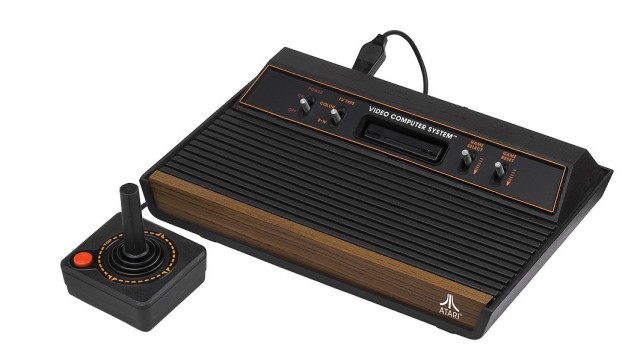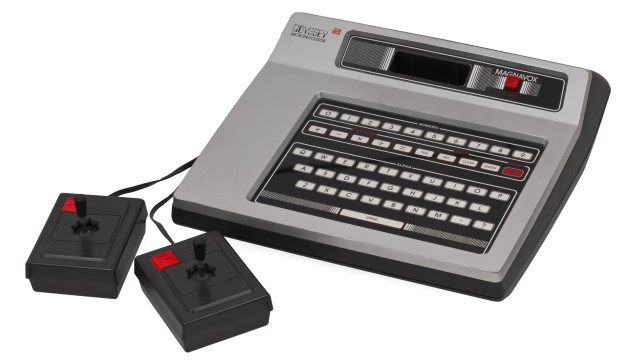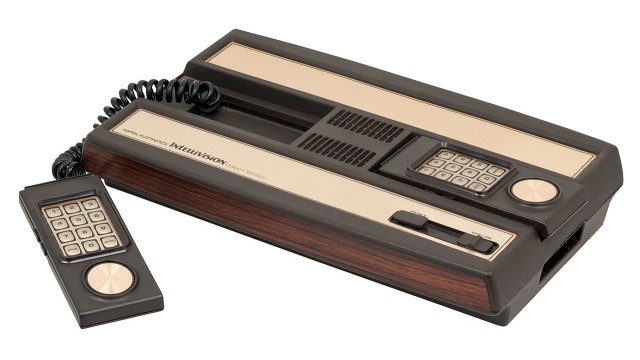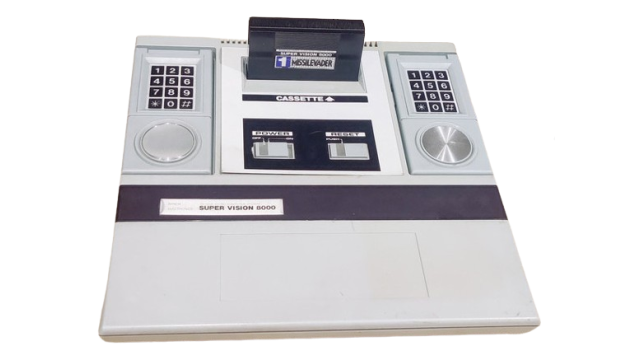
Super Vision 8000
Launches: 1979
Generation: 2nd
Country releases of Super Vision 8000
 Japan: Japan: | Dec/1979 | 59800 | ¥ |
 Super Vision 8000 technical specifications
Super Vision 8000 technical specifications
CPU: NEC D780C-1 (Z80 clone) (8 bits)
Memory: None
Unlike its predecessors in the Bandai TV Jack series, which were first-generation, Pong-style systems relying on discrete logic circuits without microprocessors, the Super Vision 8000 embraced advanced technology. It featured a central 8-bit NEC D780C-1 CPU operating at 3.58 MHz and utilized interchangeable ROM cartridges for its games, a stark departure that fundamentally changed its capabilities and market positioning.
This technological leap made it Bandai's inaugural programmable cartridge-capable console and, notably, the very first programmable cartridge-based system to be released in Japan.
Despite its technological advancements and pioneering status, the Super Vision 8000 encountered substantial commercial hurdles. Its introductory price in Japan was 59,800 Yen, a sum equivalent to approximately $1800 US dollars today when adjusted for inflation. This price point was roughly double that of other contemporary systems, creating a significant barrier to widespread consumer adoption. The console's high cost, likely a direct consequence of the considerable research and development investment required for its sophisticated hardware, severely limited its market penetration. Consequently, the Bandai Super Vision 8000 had a remarkably short commercial lifespan, being discontinued in 1982, with only seven official games released for the system.
The strategic shift undertaken by Bandai with the Super Vision 8000, moving from simpler, pre-programmed systems to a complex, CPU-driven, cartridge-based console, represented an ambitious calculated move. The company aimed to leapfrog into the second generation of consoles, envisioning a more versatile, programmable future that blurred the lines between gaming and computing. This was a bold attempt to establish leadership in a rapidly evolving market, particularly as Japan's first programmable cartridge system, and even with an eye towards the broader "computer markets". However, the prohibitive price, a direct outcome of the substantial investment in its development, proved to be a critical impediment to widespread acceptance. The market, even for innovative technology, demonstrated a strong sensitivity to cost. Bandai's subsequent decision to cease support for the Super Vision 8000 and instead transition to distributing Mattel's Intellivision in Japan indicates a strategic recalibration, acknowledging the commercial limitations of their independent hardware venture. This historical trajectory underscores the challenging realities of pioneering in a nascent industry, where technological superiority does not always guarantee market success, especially when coupled with a prohibitive price point.
 Super Vision 8000 video specifications
Super Vision 8000 video specifications
Super Vision 8000 graphics capabilities.
Video chip: Ami S68047 (Motorola 6847 clone)
Video connection:
The console supported a display palette of 16 colors.
It utilized an Ami S68047 Video Display Generator (VDG), which was a clone of the Motorola 6847. The display capabilities included:
- A resolution of 256 x 192 pixels with 2 colors in character mode (using a built-in 8x12 font).
- A 128 x 192 bitmap mode with 2 colors.
- A 128 x 96 bitmap mode with 4 colors.
 Super Vision 8000 audio specifications
Super Vision 8000 audio specifications
Super Vision 8000 sound capabilities.
Audio chip: General Instrument AY-3-8910
Audio mode:
Sound was handled by a General Instrument AY-3-8910 audio chip, which provided three sound channels and one noise generator . This chip also supported two general-purpose parallel I/O ports used for joysticks.
 Controllers of Super Vision 8000
Controllers of Super Vision 8000
The design of the Bandai Super Vision 8000 controllers is a distinctive feature of the console, characterized by their physical integration with the main unit and their unique input mechanisms. The console chassis itself was designed with integrated cradles, serving to house the two included controllers on its respective sides. This design choice meant the controllers were not detachable in the manner of many modern systems, instead forming a cohesive, all-in-one unit. The console's overall aesthetic featured a "light grey chassis" complemented by "classic black molding," creating a "clean, crisp look".
Each controller was equipped with three primary input mechanisms, reflecting the experimental nature of controller design during this era:
- 16-Way Directional Disc: A prominent feature was a round directional pad, specifically described as a "16-way directional disc," which was primarily used for character or object movement within games.
This level of directional input, offering sixteen distinct directions, was quite advanced for its time, suggesting a capability for nuanced control that aimed to provide precise player input. - 12-Button Keypad: A significant component of the controller was its 12-button keypad.
These buttons were notably characterized as "soft buttons," which may have offered a distinct tactile feel compared to the more rigid, calculator-style buttons found on some contemporary keypads. This keypad provided a range of input options, likely intended for game-specific commands or numerical entries. - Side-Mounted Fire Button: Each controller also included a single side-mounted fire button.
The combination of a 16-way directional disc and a 12-button keypad points to a design philosophy that sought to provide a wide array of precise inputs. This approach potentially aimed to cater to more complex game genres or even hinted at the console's broader "computer" aspirations. The inclusion of "soft buttons" on the keypad suggests an attempt to enhance user comfort or deliver a unique tactile experience. However, despite this ambition, the side-mounted fire button was noted for being "a bit awkward to use" and "positioned too low". This observation reveals a common tension in early console design: the desire to incorporate advanced or versatile input methods often encountered practical ergonomic challenges. While the 16-way directional disc was technologically impressive for its fidelity, the placement of the fire button indicates that user comfort and intuitive operation were still areas of significant learning for hardware developers. This illustrates that simply adding more input options or technical precision did not automatically translate to a superior user experience if the physical design was not optimized for human interaction, a critical lesson that would be refined in subsequent console generations.
| Component | Description | Key Characteristics / Notes |
|---|---|---|
| Directional Input | 16-way directional disc | Very responsive; used for movement. |
| Keypad | 12-button keypad | Soft buttons; offered a range of input options. |
| Action Button | Side-mounted fire button | Positioned too low, a bit awkward to use, but adequate. |
| Integration | Integrated into console | Cradles flank respective sides of the main unit; not detachable. |
Evaluating the practical application of the Bandai Super Vision 8000 controllers reveals a mixed user experience, characteristic of the experimental nature of early console hardware. The 16-way directional disc was consistently praised for its responsiveness, providing precise input for movement within games. This level of precision would have been a notable advantage for games requiring fine control, offering players a greater degree of manipulation over on-screen elements.
In contrast, the 12-button keypad, despite offering a broad range of input options, was met with a "general dislike" by contemporary reviewers. This suggests that, while versatile in theory, keypads were not universally popular for primary gameplay control. Their non-intuitive nature for action-oriented games or the potential need for game-specific overlays might have contributed to this lukewarm reception. The side-mounted fire button, while serving its primary function adequately, was ergonomically flawed. It was described as being "positioned too low" and "a bit awkward to use". This indicates a design compromise where the inclusion of a dedicated action button was prioritized, even if its placement did not offer optimal user comfort or intuitive access during gameplay.
The design of the Bandai Super Vision 8000's controllers, with their combination of a precise directional disc, a multi-button keypad, and a side fire button, exemplifies the significant period of experimentation in controller design that defined the second console generation. This era witnessed various manufacturers attempting to move beyond the simpler joysticks and paddles of the first generation, seeking more sophisticated input methods for increasingly complex games. The mixed reception of the Super Vision 8000's controllers—where the directional input was lauded for responsiveness, but the keypad was generally disliked, and the fire button had ergonomic flaws—is a clear reflection of the broader industry's learning curve during this period. Other second-generation consoles, such as the Intellivision, Atari 5200, and Odyssey², also experimented with keypads, often with similar mixed results. This era was characterized by a collective search for the "ideal" input device. The eventual industry shift towards more streamlined designs, like the D-pad and standardized action buttons that became prevalent in later generations, can be understood as a direct consequence of these early experiments and the market's implicit feedback. The Super Vision 8000's controller design, therefore, is not merely a collection of features; it stands as a historical data point illustrating the iterative process of controller evolution, where lessons learned from designs like this paved the way for more refined and user-friendly interfaces that would become industry standards.
The Intellivision Connection: A Study in Controller Similarity
One of the most striking and historically significant aspects of the Bandai Super Vision 8000 controllers is their remarkable resemblance to those of the Mattel Intellivision. This visual similarity frequently led observers to mistakenly believe that the Super Vision 8000 was a clone of the Intellivision. Further contributing to this perception was the shared use of the General Instrument AY-3-8910 audio co-processor by both consoles.
However, a closer examination of the historical timeline and internal hardware reveals crucial distinctions. The Bandai Super Vision 8000 was officially announced at the Tokyo Trade Show in September 1979 and subsequently released in Japan in December 1979. In contrast, the Mattel Intellivision underwent test-marketing in late 1979 and achieved its broader release in 1980. While Mattel did showcase a mockup of their Keyboard Component in January 1979, suggesting earlier development of the core console design, the Bandai console's full commercial release predates the Intellivision's widespread market availability. It is critical to note that despite the external similarities, the Super Vision 8000 is explicitly confirmed to be not a clone of the Intellivision. Their internal hardware specifications were "completely different and not compatible at all". For instance, the Super Vision 8000 employed an 8-bit NEC D780C (a Z80 clone) running at 3.58 MHz, whereas the Intellivision utilized a 16-bit GI 1600 operating at 500 kHz.
A prominent theory regarding this striking design similarity suggests that Mattel "duplicated the design of Bandai's controllers". The precise narrative behind this resemblance remains varied, with some sources speculating that Mattel was the original designer, while others lean towards Bandai's precedence. Nevertheless, evidence supports the notion that Bandai developed its controllers independently and prior to the Intellivision's widespread release. Further support for this theory comes from speculation that Bandai was considering legal action against Mattel for patent infringement when the Intellivision was first displayed. This potential legal confrontation may have served as a catalyst for a subsequent business arrangement: Bandai gained the rights in 1980 to become the sole manufacturer and distributor of the Intellivision console in Japan, a role they maintained throughout the 1980s.
This situation illuminates the complex and often fluid nature of intellectual property in the nascent video game industry. The undeniable visual similarity between the controllers of the Bandai Super Vision 8000 and the Mattel Intellivision, despite their distinct core hardware, suggests that external design elements were highly visible and susceptible to replication. The earlier release of the Bandai Super Vision 8000's full system compared to the Intellivision's general availability, coupled with the theory of Mattel duplicating Bandai's design and the subsequent consideration of a lawsuit, provides a compelling narrative. Bandai's eventual role as the sole distributor of Intellivision in Japan can be interpreted as a strategic resolution to a potential intellectual property dispute. Rather than engaging in costly and potentially damaging litigation, Mattel might have conceded by granting Bandai lucrative distribution rights in a key market like Japan, effectively acknowledging Bandai's prior design or seeking to avoid a public legal battle. This historical episode highlights how early industry players navigated design influence, intense competition, and intellectual property challenges, often through business partnerships rather than protracted court battles, thereby shaping market dynamics in a rapidly evolving technological landscape.
Controller Design Comparison: Bandai Super Vision 8000 vs. Mattel Intellivision
| Feature | Bandai Super Vision 8000 | Mattel Intellivision |
|---|---|---|
| Controller Design | 16-way directional disc, 12-button keypad, side button | Similar 16-way directional disc, 12-button keypad, side buttons |
| Release Date | December 1979 (Japan) | Test marketed late 1979, sold 1980 (US) |
| Internal CPU | 8-bit NEC D780C-1 (Z80 clone) @ 3.58 MHz | 16-bit GI 1600 @ 500 kHz |
| Audio Chip | General Instrument AY-3-8910 | General Instrument AY-3-8910 |
| Hardware Compatibility | Not compatible with Intellivision | Not compatible with Super Vision 8000 |
| Design Precedence | Released prior to Intellivision's widespread availability; theory of Mattel duplication | Released after Super Vision 8000's full release; theory of duplicating Bandai's design |
The Unreleased Keyboard
Beyond its primary controllers, the Bandai Super Vision 8000 console hinted at a broader vision for its capabilities through the inclusion of a "small divot at the bottom for possible keyboard support" in its chassis design. This physical accommodation was not merely a design quirk but a deliberate feature supporting a planned peripheral. An "optional keyboard was also planned to turn the device into a computer". This intention clearly signals Bandai's ambition to position the Super Vision 8000 beyond a dedicated gaming console, envisioning it as a more versatile home computing or entertainment system capable of performing functions beyond just playing games.
Despite this clear intent and the physical readiness of the console's design, available information does not indicate that this optional keyboard was ever released. Its unreleased status is implicitly supported by the console's remarkably short market lifespan and its limited game library, factors that likely precluded further hardware development or the introduction of additional peripherals.
The planned keyboard for the Super Vision 8000 reflects Bandai's participation in a broader industry trend of the late 1970s and early 1980s. This period saw a significant overlap between the burgeoning home computer market and the video game console market. Many console manufacturers, such as Mattel with its Intellivision Keyboard Component and Coleco with its Expansion Module #3, actively attempted to integrate computer functionality into their gaming systems. This strategy aimed to broaden their appeal and justify higher price points by presenting consoles as multi-functional home entertainment hubs. The fact that Bandai's keyboard was planned but ultimately not released, coupled with the console's overall commercial struggles, suggests that the company's ambitious vision for a multi-functional device was not fully realized. This outcome was likely due to the console's inability to gain sufficient market traction in a competitive landscape where dedicated home computers were also rapidly gaining prominence. This historical detail highlights the challenges inherent in attempting to create a hybrid device in a rapidly evolving technological environment.
 Super Vision 8000 games support
Super Vision 8000 games support
Support: Cartridge
The Super Vision 8000 emerged as a second-generation console, distinguished by its inclusion of a central CPU and its innovative support for ROM cartridges. This shift to a programmable, cartridge-based architecture was a substantial technical leap for Bandai, establishing the company as an early innovator in the Japanese video game hardware sector.This transition underscores a strategic reorientation in Bandai's hardware philosophy. The adoption of ROM cartridges was not merely an incremental technological upgrade but a foundational change in how games were delivered and how the console functioned. Unlike fixed-game systems, cartridges enabled an expandable library, offering greater versatility and potential for diverse gaming experiences. This strategic pivot was accompanied by a "massive investment in R&D" for the console and its new ROM format, highlighting Bandai's commitment to this advanced and potentially lucrative market segment, despite their acknowledged lack of prior experience in developing such a complex console.
The physical characteristics of the Super Vision 8000 cartridges are consistently described as "medium sized and well constructed". While precise dimensions are not explicitly provided in the available documentation, this general description suggests a robust and durable build quality. The console itself was designed with integrated cradles on its sides to house the two hard-wired controllers, and a subtle divot at the bottom hinted at the possibility of future keyboard support. However, detailed physical specifications for the cartridge slot or its connector type are not readily available in the provided research material. Visual documentation, including images of the game boxes and their packaging, exists for the seven titles released on this platform.The emphasis on "well constructed" cartridges points to a deliberate design philosophy focused on durability and perceived value, especially considering the high initial cost of the console. The Super Vision 8000 retailed at ¥59,800, which converted to approximately $1800 USD in 2023, making it a substantial investment for consumers at the time. In a nascent market where consumers were committing significant financial resources to new gaming technology, the tangible quality and longevity of physical components, such as the game cartridges, would have been paramount for fostering consumer confidence and justifying the premium price point. This robust construction was likely a strategic choice to align with the console's high cost and to ensure the resilience of this novel and expensive media format for Bandai.
The Bandai Super Vision 8000 exclusively utilized ROM cartridges as its primary medium for game distribution. These cartridges interfaced directly with the console's central processing unit, an 8-bit NEC D780C-1 (a Z80 clone) operating at 3.58 MHz. The system's graphical output was managed by an Ami S68047 Video Display Generator (a Motorola 6847 clone), and audio was handled by a General Instrument AY-3-8910 chip, capable of producing three-channel sound with an additional noise generator. The console was equipped with 1KB of RAM and 3KB of Video RAM (VRAM), which the cartridge-based software would leverage for game logic and display.A notable aspect of the cartridge technology concerns its ROM capacity. While MAME emulation, a common tool for preserving and playing these vintage games, typically limits the emulated ROM size for Super Vision 8000 titles to 4KB , more in-depth hardware analysis reveals a different picture. Reverse engineering efforts indicate that the cartridge port itself possesses the capability to support ROMs up to 128KB. Furthermore, these investigations have uncovered the presence of "two 8K SRAMs... physically glop-tops on little tiny carrier boards" within the cartridges. This finding is significant because it demonstrates that the cartridges were not merely static ROM carriers but could also incorporate volatile memory, potentially for saving game data or expanding the program's working memory during gameplay.The disparity between the hardware's theoretical capacity (up to 128KB ROM and integrated SRAM) and the observed 4KB size of most emulated ROMs for released games points to considerable economic and developmental challenges. The "massive investment in R&D" that Bandai poured into this new ROM format , coupled with the console's high retail price, likely rendered the production of larger, more complex games prohibitively expensive. Fully utilizing the 128KB ROM capacity or the integrated SRAM for advanced features like game saves would have further inflated development and manufacturing costs for a system that ultimately struggled to gain market traction and was quickly discontinued. This suggests that the technical prowess of the cartridges, while advanced for their time, largely outstripped the commercial viability of fully exploiting their capabilities within the prevailing market conditions.
Despite the available information regarding the Bandai Super Vision 8000 console's internal architecture, detailed technical diagrams specifically pertaining to the cartridges remain largely undocumented in the provided research material. Comprehensive specifications such as pinout configurations or intricate internal Printed Circuit Board (PCB) photographs are notably absent. While reverse engineering notes offer a rare glimpse into some internal components, such as the identification of 8K SRAMs mounted on "glop-tops" within the cartridges , these do not constitute a complete pinout or detailed schematics. The general scarcity of official manuals or schematics for the console itself further exacerbates this information void concerning its cartridge technology.The fact that the most granular technical details about the cartridge internals—such as the presence of SRAMs and the potential for ROM capacities far exceeding the common 4KB emulation limit—stem from community-driven reverse engineering efforts rather than official corporate documentation highlights a significant research gap. This suggests that a substantial portion of the in-depth technical understanding of these rare artifacts relies on the dedicated work of enthusiasts and hardware engineers. These individuals play a crucial role in uncovering and documenting the intricacies of systems like the Super Vision 8000, thereby compensating for the absence of historical corporate transparency or dedicated preservation initiatives. This underscores the vital contribution of retro-computing communities and reverse engineering in safeguarding the technical heritage of commercially unsuccessful or poorly documented hardware.Furthermore, while the concept of copy protection is discussed in general terms in some sources , there is no specific mention or evidence of any sophisticated copy protection mechanisms implemented on the Bandai Super Vision 8000 cartridges. This absence, when considered alongside the console's commercial failure and its short market presence , strongly suggests that advanced anti-piracy measures were either not developed or deemed unnecessary. Implementing robust copy protection adds complexity and cost to cartridge manufacturing. For a system that struggled to achieve market penetration and was quickly withdrawn, investing additional resources into anti-piracy features would have been an illogical business decision. This observation points to the economic realities faced by early console manufacturers, where the commercial viability of a system often dictated the prioritization of features, with copy protection likely taking a backseat when market struggles overshadowed piracy concerns.
The Bandai Super Vision 8000 console and its game cartridges have found a new life through modern emulation efforts, notably via projects like MAME (Multiple Arcade Machine Emulator) and its libretro core. These emulators serve as critical tools for the digital preservation and continued playability of the system's exceptionally rare game library. Through emulation, enthusiasts and historians can experience the console's limited software catalog, which otherwise would be largely inaccessible due to the scarcity of original hardware and cartridges. A key technical detail in the emulation context is MAME's imposed ROM size limit of 4KB for Super Vision 8000 cartridges. This limit, while reflecting the observed sizes of the official game ROMs released by Bandai, stands in contrast to the hardware's theoretical capability to support much larger ROMs, potentially up to 128KB, as revealed by hardware reverse engineering. The adherence to this 4KB limit in emulation provides a practical representation of the constraints that game developers faced when creating titles for the Super Vision 8000. It is understood that the actual games released were confined to this smaller size, likely a confluence of factors including the high development costs, the expenses associated with cartridge production, and the console's overall limited commercial success.
Emulation, by accurately replicating these practical limitations, offers a valuable window into the original gaming experience and the technical realities of the era. It not only preserves the software but also helps to illustrate the design choices and compromises that shaped the console's library, even when those choices did not fully exploit the hardware's maximum theoretical capabilities. This process provides a deeper understanding of the real-world technical environment in which the Bandai Super Vision 8000 and its cartridges operated.
Physically, these cartridges were designed to be robust and well-constructed, a characteristic likely intended to convey value and durability given the console's high price point.
Technically, they were advanced for their time, capable of supporting ROM sizes up to 128KB and even incorporating internal SRAM components for expanded functionality, such as potential game saves.
The substantial investment required for cartridge production, coupled with the console's prohibitive retail cost, led to a meager game library consisting of only seven relatively small titles. This economic pressure forced Bandai to prioritize simpler, less ambitious game designs, ultimately contributing to the console's short lifespan and its rarity today.
Super Vision 8000 games
Games library:
Exists seven games released for the console developeds by Bandai Electronics and released in 1979.
- Missile Vader
- Space Fire
- Othello
- Gun Professional
- PacPacBird
- Submarine
- Beam Galaxian
The extremely limited size of the game library is a direct consequence of the substantial costs associated with developing and producing ROM cartridges in Japan during that era. This economic barrier meant that Bandai likely had to be highly selective in its game releases, prioritizing titles that were simpler to develop and had a higher probability of commercial appeal. For instance, "Missile Vader" was a well-executed clone of the popular "Space Invaders," a design choice that minimized development risk.The financial constraints imposed by the advanced cartridge technology, combined with the console's high retail price and subsequent poor sales, severely restricted the diversity and experimental nature of the game offerings. This economic pressure compelled Bandai to focus on a minimal set of proven arcade-style concepts, rather than investing in a broader or more innovative software portfolio. The direct cause-and-effect relationship between the high cost of the cartridge technology and the console's sparse game catalog ultimately contributed to its rapid discontinuation.
Super Vision 8000 story
The Bandai Super Vision 8000 is a relatively obscure chapter in the history of video game consoles, often overshadowed by its more prominent contemporaries. However, its development and market presence provide an intriguing glimpse into the competitive landscape of early 1980s gaming.
The creation of the Super Vision 8000 was part of Bandai’s broader strategy to enter the burgeoning home video game market. Bandai, a well-known Japanese toy manufacturer, had a history of producing various entertainment products, including arcade games. By the early 1980s, the success of consoles like the Atari 2600 and the Intellivision demonstrated the potential for home gaming systems, and Bandai sought to capitalize on this growing market.
Bandai’s approach to the Super Vision 8000 involved leveraging its expertise in electronics and entertainment to create a console that could compete with existing systems. The goal was to produce a system that combined affordability with engaging gameplay, aiming to capture a segment of the market that was increasingly interested in home video games. The company embarked on creating a console that was both functional and appealing, with a focus on delivering a satisfying gaming experience for consumers.
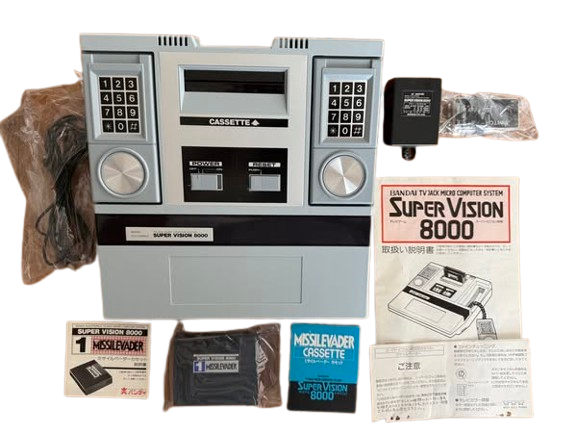

The development of the Super Vision 8000 was influenced by the technical and market conditions of the time. The console was designed to be compatible with a variety of video game cartridges, which allowed for a diverse range of games to be played on the system. This cartridge-based approach was standard for home consoles of the era and helped to ensure that the Super Vision 8000 could offer a variety of gaming experiences. The development process included creating a system that was not only technically sound but also user-friendly, aiming to provide a straightforward and enjoyable gaming experience.
One of the notable aspects of the Super Vision 8000 was its design. The console featured a distinctive appearance, with a compact form factor that was intended to be visually appealing and easy to integrate into a home entertainment setup. The design reflected Bandai’s emphasis on creating a product that was both functional and aesthetically pleasing, contributing to its appeal to potential buyers.
The launch of the Super Vision 8000 took place in 1983, during a period of intense competition in the home gaming market. The console was introduced with a range of marketing efforts designed to attract consumers and differentiate it from other available systems. Bandai promoted the Super Vision 8000 as an affordable and versatile option for home gaming, positioning it as a viable alternative to more established consoles like the Atari 2600 and the Intellivision.
Despite these efforts, the market reception of the Super Vision 8000 was relatively modest. While the console did manage to attract some attention and had a presence in the market, it faced significant challenges. The gaming industry in the early 1980s was characterized by rapid technological advancements and fierce competition. Established companies like Atari, Mattel, and Intellivision had already built strong market positions with their products, and new entrants struggled to make a significant impact.
The Super Vision 8000’s performance in the market was also affected by broader industry trends. The early 1980s saw a significant video game crash, driven by factors such as oversaturation of the market, a flood of low-quality games, and declining consumer confidence. This crash negatively impacted many video game consoles, including the Super Vision 8000, which struggled to gain traction in a challenging economic environment.
Despite its limited commercial success, the Super Vision 8000 holds a place in the history of video gaming as an example of the numerous attempts made by various companies to capture a share of the growing home console market. Bandai’s efforts to enter this competitive field reflect the broader trends of the time, where innovation and market strategy played crucial roles in determining the success of new gaming systems.
Today, the Bandai Super Vision 8000 is remembered as a niche product that, while not achieving widespread success, contributed to the rich tapestry of video game history. It serves as a reminder of the many different approaches and ideas that were explored during the early years of home gaming, and its place in this era of technological experimentation and competition.

